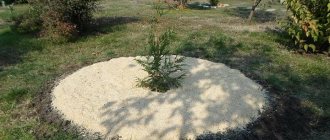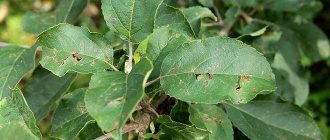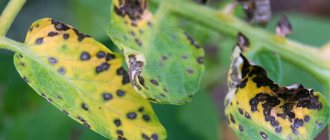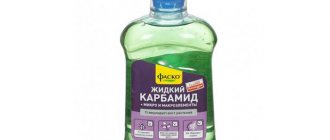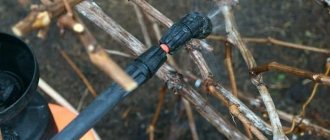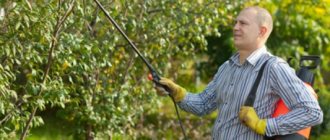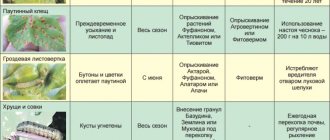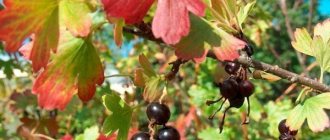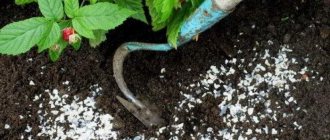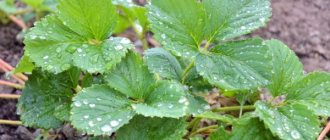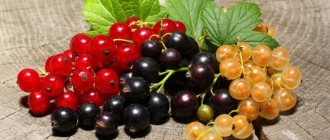Why process a pear
Pear processing is necessary for the reason that parasites attack the tree and destroy it. They destroy not only the culture, but also the fruits. Pests live on leaves, bark, ovaries and buds. The parasite larvae gradually spread on ripe fruits, which spoils the harvest. In addition, fruits affected by pests often do not ripen and begin to fall earlier than expected.
The entire tree suffers from parasites. Invasion of entire colonies often occurs, which causes leaf wilting and early leaf fall. The situation may be aggravated by the fact that insects can become carriers of various diseases in the garden. Therefore, the pear needs to be treated several times during the season with special pest control agents. This approach will effectively solve the problem, because helps destroy unwanted “neighbors” at all stages of their development.
Preventive actions
Pests and diseases are constant companions of any garden plantings. Both beginners and experienced gardeners are not immune from their occurrence, so the entire scope of preventive measures plays a primary role in the protection of fruit crops.
Diseases of pear trees can cause many problems for amateur gardeners, and very often cause partial or complete loss of harvest, and in some cases, the death of fruit trees. Carrying out correct and timely treatment and a full range of preventive measures help protect the fruit plant, as well as restore fruiting in the shortest possible time.
Timing for processing pears in autumn
It is necessary to treat pear trees in the fall immediately after harvesting the fruits and falling leaves. In central Russia this is done in October. Before carrying out the operation, you will need to do some sanitary pruning of the branches in advance.
Despite these rules, gardeners, especially those with experience, have divided opinions on this:
- Some are convinced that crop cultivation should only be done after the leaves have fallen, when the tree enters the dormant stage. Almost by this moment they will have already closed, which means they will not suffer from the drugs used;
- others believe that the plant should be sprayed two to three weeks before the leaves fall. This means that processing should be carried out on yellow leaves, but after collecting ripe fruits.
Attention!
If you choose the second option, then you need to prepare for the fact that the foliage will turn black, but do not be alarmed - everything is going as it should. This is how the tree begins to prepare for winter.
Whatever decision is made, there is no need to delay spraying too much - this should be done before the first frost sets in. Otherwise, the means used will not give any result. The action of fungicides and insecticides will only be effective if the outside temperature is not lower than +5℃.
Recommendations of professionals and processing rules
Effective treatment of pears against rust is not carried out in an iron bucket. Most of the chemicals used will react and result in a mixture that is toxic to the tree. The second recommendation is that all work is carried out in clean containers. As soon as the manipulations are completed, the container is thoroughly washed. The third recommendation is to prevent any substances used from coming into contact with open areas of the body or mucous surfaces.
Other recommendations:
- do not inhale the vapor of the substances used;
- the level of concentration of substances is commensurate with the volume of the lesion;
- Regular standardized fertilizing increases the protective properties of the plant.
Attention!
Treatment with vitriol is carried out after pruning.
Autumn preventive treatment of seedlings reduces the likelihood of crop loss in the spring. All activities are completed 2.5-3 weeks before frost. Spraying is carried out from 18 to 20 hours, in dry and windless weather. Strictly follow the recommended dosage indicated on the drug packaging. At an early stage, biologically active drugs are used. They accumulate to a lesser extent in fruits.
Preparing pears for autumn processing
In the fall, it is important to cultivate this crop, because... It is at this time that parasites begin to look for a place to winter. This could be soil, bark, foliage.
Such actions prevent the appearance and development of fungal infections. Flowering may slow down due to the proliferation of bacteria that cause these diseases. For this reason, timely treatment will help get rid of parasites, diseases, and also preserve the harvest for next year.
But before the operation you need to prepare the pear. To do this, you will need to do the following, taking into account the age of the plant:
- For trees older than 6 years, lichen and old bark must be removed using metal brushes. This procedure is needed to prevent parasites from hiding;
- When the unnecessary parts of the tree are removed, you should start spraying. This should be done after complete leaf fall. It is permissible to do this even after the onset of the first frost. But before this, the garden plot must be cleared of old branches, weeds, fallen leaves - pests and their larvae, as well as pathogens, can overwinter in them.
The processing procedure itself is simple. You just need to properly dilute the selected drug.
Pear variety with red leaves. Special demand for red pears
Red-fruited pears are in particular demand among both gardeners and market buyers.
Sweet and sour Starkrimson
The Starkrimson variety is considered one of the most unpretentious. He is not affected by scab and almost never suffers from other fungal diseases. Quite winter-hardy and productive. The fruits are large, up to 180-250 g. Pears are red from the appearance of the ovary, and after harvesting they settle for several weeks.
When fully ripe, pears lighten a little, so you can spot ripe ones simply by eye.
The variety begins to bear fruit in the seventh year of life, and decent yields are obtained only in the tenth year of life. This serious drawback can be corrected by grafting onto quince rootstock. Then the trees begin to bear fruit in the fifth year of life.
Starcrimson is not self-fertile and requires pollination by other varieties. However, this does not prevent us from producing abundant harvests every year. When ripe, the fruit pulp is white, melts in the mouth, and has a pleasant sweet and sour taste. The fruits are stored for 30 days. Overall, an almost ideal variety for the patient gardener.
Noble Williams Red
Williams Red is another red-fruited variety of French origin. Quite resistant to frost, but during prolonged and severe frosts, individual branches may freeze. But Williams is resistant to scab, is distinguished by early fruiting and the highest yield.
Disadvantage: it can be seriously overloaded with the harvest, which is why the fruits become smaller and the taste deteriorates. The trees grow to medium height and have a compact crown. Fruit weight is 160-190. But some fruits can reach 270 g.
The fruits are a beautiful pink-red color, sometimes with small spots of rust. The harvest ripens at the end of summer or at the first signs of autumn. The pulp is cream-colored, juicy, with a delicate taste and nutmeg aroma. Transportability is quite good. The fruits are eaten not only fresh, but also excellent compotes, juices, jams are prepared...
Dicolor is a new product for southerners
A new product for southern latitudes, the Dicolor variety is a winter pear. The harvest is stored until January. A very productive variety, but requires crop rationing. Overloaded branches may simply break under the weight of the fruit. The fruits are large, 200 g. There is a beautiful red blush over the entire surface. Mass ripening occurs in October.
Irresistible Rosie Red Bartlett
But the real beauty is the Rosie Red Bartlett variety. He has very beautiful red pears, relatively large and very tasty. The fruits are dark cherry in color. It bears fruit in the fifth year after planting, ripens in mid-August, and is distinguished by a consistently high yield.
How and with what to treat pears against diseases in autumn
The fight against diseases in the fall becomes more serious compared to the summer. For this reason, gardeners use fungicides and chemicals.
Powdery mildew
This disease poses a danger not only for pear trees - all plants in the garden can suffer from it. The fungus appears as a white coating, reminiscent of a cobweb, which gradually becomes gray with dark spots. Powdery mildew affects foliage and shoots.
Attention!
When the disease has entered the active stage, the crop slows down its growth, and the leaves begin to curl and fall off.
Treatment with copper sulfate or colloidal sulfur will help get rid of this scourge.
Rust
If the first signs of rust appear in the fall, then you cannot postpone the fight against it until spring. This is due to the fact that fungal spores quickly wake up from sleep and also quickly begin to spread. You also need to take into account that in the event of a large-scale problem, it will not be possible to cure the crop in a season. In autumn you can use:
- urea at the rate of 700 g per 10 liters of water. The resulting preparation must be used to treat the tree and the soil around it;
- a solution of colloidal sulfur, for the preparation of which you should grind 40 g of powder in 1 liter of water. After this, dilute the resulting product in a bucket of liquid. Sulfur dissolves poorly, but settles well on the branches, so they are protected and healed.
The drug “Svor” is effective in the fight against rust. He demonstrates the best results together with “Fitoldavin”
Scab
This fungus attacks ripening fruits and spreads quickly in autumn. It can be visually identified by a dark velvety coating in the form of spots. Often they begin to merge with each other. Scab develops actively in spring and summer, when outside temperatures and humidity are high.
The disease can be overcome by treating the crop. It is carried out in several stages:
- before the flowering period, use 3% Bordeaux mixture;
- after the growing season, repeat the procedure with this liquid, but at a concentration of 1%;
- After two weeks and a month, treat again with the same product.
Instead of Bordeaux mixture, use the preparations “Raek” and “Chorus”, the distinctive feature of which is the accumulative effect in the culture tissues.
Fruit rot
You need to start treatment immediately after the first signs of the disease are detected. To do this you should:
- remove plant debris;
- use “Hom”, “Topaz”, “Abiga-Pik” for spraying;
- treat the trunk circle with “Fitosporin”, copper or iron sulfate. For prevention, you can also spray the crown.
Attention!
Experts are convinced that only varieties that are resistant to disease development should be grown in the garden.
It is necessary to regularly inspect the fruits of the plant; if they are spoiled, they should not be used for laying in a compost pit.
Prevention measures
Regular preventative treatments will help prevent the occurrence of diseases and pests:
- Mandatory spring preventative treatments of wood with Bordeaux mixture.
- Whitewashing in spring and autumn will protect the pear from leaf rollers and other pests.
- Hunting belts or traps are installed on the trunks.
- Regular removal of fallen leaves will reduce the likelihood of infection with fungal diseases.
Compliance with a number of agrotechnical requirements will help maintain the tree’s immunity and protect it from negative impacts:
- Perform pruning in a timely manner.
- Monitor the humidity of the tree trunk circle.
- Feed the crop in a timely manner.
- Choose the right neighbors for the pear tree on your property.
- Thinning the crown will help prevent scab.
Rules for treating pears against pests in the fall
It is best to treat plants against pests in the fall. This is important because many are convinced that in winter the parasites will be destroyed, but this opinion is wrong. If insect activity is noticed in winter, you should immediately spray the trees with insecticides. You need to separate them using the instructions.
Copperhead and hawthorn
The copperhead damages pear branches - a dark coating appears on them. Because of this, the buds become depressed, and fruits and leaves begin to fall off. The drug “Nitrophen” will help destroy pests.
Hawthorn caterpillars spend the winter in fallen leaves, and in the spring they wake up and begin to eat the buds. New generations of parasites feed on leaves, which eventually begin to curl and become an excellent shelter for the insect. You can get rid of caterpillars using biological preparations. For prevention, you can treat the crop in the spring and peppers during flowering.
Goldentail
Another parasitic caterpillar. It affects foliage and buds. In addition, the culture itself suffers from it. The parasite spends the winter on shoots.
A drug called “Entobacterin” will help get rid of goldentail. For a rich harvest, you need to process the plants on time.
Mite
The pear is severely affected by mites. It feeds on the juice of leaves and makes various punctures in them. The leaf plate will indicate the presence of a pest: swellings will appear on it, which change their color from yellow to brown.
There is no photosynthesis in the affected leaves, so the fruit is deficient in nutritional components. As a result, they fall off before reaching maturity and optimal size.
To combat ticks, you need to use several methods. Initially, treatment with various chemicals will be required.
Attention!
As a result of this approach to fighting the parasite, it does not become addictive to the means used.
You will also need to clear the garden of fallen leaves, clear the trunks and constantly fertilize the plants.
Flower beetle
This pest is the weevil. It's not easy to get it out, but it's possible. This is important because the insect can greatly damage the garden plot. The beetles use the flowers of the plant for food. In addition, females lay eggs in the kidneys, and the larvae that hatch begin to eat them from the inside. This leads to reduced yield and even loss.
To exterminate the parasite, you need to hang sticky tape or a catching belt on the tree. The weevil can be collected by hand or simply shaken off the branches. Spraying will also be required. The first procedure should be carried out before the buds open, and the second - in early autumn. Thanks to this, it will be possible to exterminate the females before they have time to lay eggs.
Processing pears with folk remedies
Folk remedies are not very effective, and they cannot destroy parasites, but only scare them away. There are the following recipes against pests:
- Dilute 200 g of wood ash in a bucket of hot water. Leave the solution for 24 hours. Before spraying crops, strain the resulting product and add 50 g of laundry soap shavings. This will make the solution more stable.
- Garlic-dandelion infusion. Chop 500 g of dandelion leaves and add 1 liter of water. Leave to infuse for 24 hours. After this time, boil for a quarter of an hour, squeeze 2 cloves of garlic into the resulting mixture. Cook for another 5 minutes. Cool, let it brew, strain. Before use, dilute the concentrate with water in a ratio of 1:10 and add 1 tbsp. liquid soap. Spray with the resulting product weekly.
- For spraying crops against parasites, a solution prepared from a bucket of water, 40 g of citric acid and 25 g of iron sulfate is suitable.
All drugs should be prepared only before use. Otherwise they will lose their properties.
Main reasons
There are many known reasons why pear foliage turns red. This could be a deficiency of vitamins in the soil, disease contamination, groundwater and much more. Each problem has its own solutions.
Red pear leaves
This section will explain in detail why pear leaves turn red in summer and how to properly fight infections.
Incompatible rootstock and scion
It is considered the most hopeless case. This is due to the fact that lately everyone has been buying already grafted seedlings and their quality leaves much to be desired. As a rule, there are two methods of grafting - clonal and seed rootstocks. If the rootstock is grown from the seed of a wild pear, then the desired variety is grafted onto the wild pear and the tree develops without problems.
You should also know why pear leaves turn red due to clonal rootstock. The materials used are obtained from short cuttings of another type of pear, as well as quince or other crops. Typically, clonal rootstock is used to increase the speed of fruiting, as well as for resistance to the influence of groundwater. The peculiarity is that the clone and the varietal branch may not suit each other, and their incompatibility will not appear immediately. In this case, you will have to accept the death of the pear tree and plant a new one.
Note! To avoid such troubles, you should purchase seedlings from well-known soda centers. When purchasing, they guarantee to check the culture and scion for compatibility.
Phosphorus deficiency
Leaves may turn burgundy due to a deficiency of components, particularly phosphorus. The main sign of deficiency is the leaf curling and the usual color changing to purple. The foliage begins to fall prematurely, and the fruits stop ripening. In this case, phosphorus-containing fertilizer will help.
It is recommended to fertilize pears with ammophos solution a couple of times a month. The drug is applied to the root zone, the diameter of the tree crown will be the guide. The first feeding should be carried out in April for maximum effect. Since the solution contains nitrogen, which has a detrimental effect on fruit development, procedures should be stopped by the end of June.
Recessed landing
Illiterate planting of a pear sometimes causes the leaves to turn red. The root collar of seedlings should be flush with the ground. If part of the trunk is buried along with the roots, the process of rotting may begin. This stops the flow of juice and vitamins into the crown of the tree, as a result the leaves change their color and dry out.
Correct planting of the pear
Note! If there is a suspicion that the roots have begun to rot, they should be lifted along with a lump of earth. The process is quite simple - you should dig around the tree in a circle, then lift it.
Excess lime
A large amount of lime leads to iron deficiency, which interferes with the production of chlorophyll. The problem can be solved quickly: you need to dig a ditch 20 cm deep, then add humus into it, water it generously and cover it with soil. It is important to be careful when using manure as it can burn the roots of the tree.
Pear diseases
A large number of crop diseases are known. This includes black cancer, a fungal infection, and brown spot. Diseases need to be treated in early spring, when sap flow has not yet begun.
Black pear cancer
An ash-soap solution will help get rid of the disease. One liter of ash is enough for ten liters of solution. Cooking method:
- Mix three liters of water with ash, then boil for 15-20 minutes.
- Then add the remaining water and mix thoroughly.
- Leave the solution for about 3-4 hours.
- Before spraying, add 50 g of laundry soap so that the medicine stays on the trees longer.
- If the solution is used in July or August, then you cannot add another 40 g of nitrophoska.
The resulting remedy will be effective against major diseases, as well as against some insect pests. It can be used every week - from May to September inclusive.
Flooding or near groundwater
Redness of the leaves also occurs due to waterlogged soil. Excess moisture becomes an obstacle to the flow of air to the roots, and the breathing of the entire root system is disrupted.
The location for planting a pear often turns out to be unsuccessful if it is a lowland or an area with close groundwater, as well as with stagnant moisture after precipitation. Even if the pear develops well in the lowlands, it is still better to replant it in the fall. A raised bed or raised bed is a good choice for a new location.
Pests: pear gall mite and aphids
The next reason why pear leaves turn red is the appearance of mites or aphids. As for aphids, the leaves affected by it fold in half. Thickenings (galls) are clearly visible on the outer leaf plate. Insect colonies live in them. Aphids are very prolific, so treatment should begin as soon as possible.
If ticks become infested, the leaves begin to curl and dark red pimples appear on their outer side. A good way to prevent ticks is to clear trees of old bark. Gardeners also advise making catching belts and planting dill, which attracts beneficial insects.
Potassium deficiency
Due to a lack of potassium, the effectiveness of phosphorus and nitrogen decreases. Accordingly, the amount of harvest will decrease, and the pear itself will be less resistant to infectious diseases. Symptoms of potassium deficiency appear in the summer in the form of redness and necrosis of the leaves. The watery tissue is clearly visible on the lower part of the plate, and the leaves themselves do not fall off, but remain on the tree until the end of the growing season. To replenish the amount of minerals, you can spray the foliage with a solution of potassium salt (0.5%).
Rules for processing pears in autumn for winter
Before you start processing the plant, you must first assess the scale of the work and understand how much product is required. A young tree will need a maximum of 2 liters of solution, and an adult tree will need about 10 liters. When using special products, you will need to strictly follow the instructions during dilution.
Attention!
If the dosage or concentration of the substance is exceeded, irreparable harm can be caused to the tree.
The treatment should be done in the evening or on a dry, cool day. Under such conditions, the solution dries longer and is well absorbed by plant tissue, therefore increasing the effectiveness of the procedure.
Spraying should begin from the top of the plant, going around it in a circle and going down to the roots. We must try to process it so that the drug covers the entire culture. The trunk of the crop also needs to be sprayed, because parasites can hide in the bark, soil and top layer of soil.
A garden sprayer with a long hose and a large container is ideal for this purpose.
Pear trees, especially young ones, suffer from hares and rodents in winter. At the latest, trunks up to a height of 1 m can be coated with clay mash (mix clay and mullein in equal proportions, add water to obtain the ideal consistency). You can not apply this composition, but wrap the trunks with spruce branches made of pine needles or hard burlap. But this must be done in such a way that the shelter does not slide to the ground.
Before wrapping, you still need to whiten the trunk as high as possible, reaching the skeletal branches. Thanks to whitewashing, the tree will be protected from UV rays in late winter and early spring. For a whitewash solution, you need to dilute 400-500 g of copper sulfate, approximately 2 kg of lime and 200 g of casein glue in 10 liters of water.
Reason 4. The pear is planted too deep.
If the tree is deeply buried, the roots begin to rot, sap flow is disrupted and the foliage turns red. Experienced gardeners plant pears up to the root collar (not to be confused with the grafting site!), otherwise the bark begins to rot.
What to do? The young plant must be dug in from all sides and raised with a clod of earth. Keep in mind: the top layer of soil may rise in the future - you will add humus and compost under the tree, and cover the soil with mulch. Never over-bury the pears!
